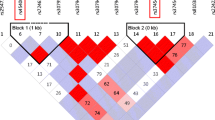Abstract
The TGF-beta signaling pathway is important in the development and invasion of cancers. Int7G24A is an intronic variant of TGF-beta receptor type 1 and has been shown to be associated with the occurrence of some kinds of cancers. Nevertheless, the association of this polymorphism with osteosarcoma is unknown. In this study, we evaluated Int7G24A variant frequencies in osteosarcoma cases. The case–control study involved 168 osteosarcoma patients and 168 age- and gender-matched controls. The blood samples were obtained, and Int7G24A variant was determined by PCR amplification and DNA sequencing. The odds ratio (OR) and 95% confidence interval (95% CI) for the Int7G24A polymorphism were calculated using unconditional logistic regression adjusted for age and gender. Three analysis models, which are the dominant model, additive model and recessive model, were used to analyze the contribution of Int7G24A variant to osteosarcoma susceptibility. Heterozygotic and homozygotic Int7G24A variants were 33.93 and 6.55% in total 168 cases, while they were 28.57 and 2.98%, respectively, in total 168 controls. The ORs for homozygosity and heterozygosity of Int7G24A allele were 1.56 [95% CI, 0.98–1.83] and 2.89 [95% CI, 1.46–4.92] in additive model. The ORs of Int7G24A genotypes in dominant model and in recessive model were 1.75 [95% CI, 1.21–2.68] and 2.21 [95% CI, 1.34–4.72], respectively. There were significant increases in Int7G24A variants in osteosarcoma cases when compared to control in every three models. Further analysis showed that Int7G24A genotypes were not associated with gender and osteosarcoma location of the cases. However, Int7G24A was significantly increased in the cases less than 20 years old. Moreover, Int7G24A was significantly associated with increased distant metastasis of osteosarcoma. It is concluded that Int7G24A is a polymorphism of TGFBR1 that is associated with the susceptibility and distant metastasis of osteosarcoma.
Similar content being viewed by others
References
Dorfman HD, Czerniak B. Bone cancers. Cancer. 1995;75:203–10.
Messerschmitt PJ, Garcia RM, Abdul-Karim FW, Greenfield EM, Getty PJ. Osteosarcoma. J Am Acad Orthop Surg. 2009;17:515–27.
McIntyre JF, Smith-Sorensen B, Friend SH, Kassell J, Borresen AL, et al. Germline mutations of the p53 tumor suppressor gene in children with osteosarcoma. J Clin Oncol. 1994;12:925–30.
Massague J. Tgfbeta in cancer. Cell. 2008;134:215–30.
Neil JR, Galliher AJ, Schiemann WP. Tgf-beta in cancer and other diseases. Future Oncol. 2006;2:185–9.
Podar K, Raje N, Anderson KC. Inhibition of the tgf-beta signaling pathway in tumor cells. Recent Results Cancer Res. 2007;172:77–97.
Mioh H, Chen JK. Differential inhibitory effects of tgf-beta on egf-, pdgf-, and hbgf-1-stimulated mg63 human osteosarcoma cell growth: possible involvement of growth factor interactions at the receptor and postreceptor levels. J Cell Physiol. 1989;139:509–16.
Seitz PK, Zhu BT, Cooper CW. Effect of transforming growth factor beta on parathyroid hormone receptor binding and camp formation in rat osteosarcoma cells. J Bone Miner Res. 1992;7:541–6.
Pontbriant CM, Chen JK, Orlando JA. Tgf-beta inhibits the platelet-derived growth factor-induced formation of inositol trisphosphate in mg-63 human osteosarcoma cells. J Cell Physiol. 1990;145:488–95.
Derynck R, Feng XH. Tgf-beta receptor signaling. Biochim Biophys Acta. 1997;1333:F105–50.
Roberts AB. Tgf-beta signaling from receptors to the nucleus. Microbes Infect. 1999;1:1265–73.
Chen T, Jackson CR, Link A, Markey MP, Colligan BM, et al. Int7g24a variant of transforming growth factor-beta receptor type i is associated with invasive breast cancer. Clin Cancer Res. 2006;12:392–7.
Rosman DS, Kaklamani V, Pasche B. New insights into breast cancer genetics and impact on patient management. Curr Treat Options Oncol. 2007;8:61–73.
Song B, Margolin S, Skoglund J, Zhou X, Rantala J, et al. Tgfbr1(*)6a and int7g24a variants of transforming growth factor-beta receptor 1 in swedish familial and sporadic breast cancer. Br J Cancer. 2007;97:1175–9.
Kaklamani VG, Hou N, Bian Y, Reich J, Offit K, et al. Tgfbr1*6a and cancer risk: a meta-analysis of seven case-control studies. J Clin Oncol. 2003;21:3236–43.
Chen T, Jackson C, Costello B, Singer N, Colligan B, et al. An intronic variant of the tgfbr1 gene is associated with carcinomas of the kidney and bladder. Int J Cancer. 2004;112:420–5.
Zhang HT. Int7g24a variant of the tgfbr1 gene and cancer risk: a meta-analysis of three case-control studies. Lung Cancer. 2005;49:419–20.
Roberts AB, Thompson NL, Heine U, Flanders C, Sporn MB. Transforming growth factor-beta: possible roles in carcinogenesis. Br J Cancer. 1988;57:594–600.
Fynan TM, Reiss M. Resistance to inhibition of cell growth by transforming growth factor-beta and its role in oncogenesis. Crit Rev Oncog. 1993;4:493–540.
Miyajima A, Asano T, Seta K, Asano T, Kakoi N, et al. Loss of expression of transforming growth factor-beta receptor as a prognostic factor in patients with renal cell carcinoma. Urology. 2003;61:1072–7.
Kloen P, Jennings CL, Gebhardt MC, Springfield DS, Mankin HJ. Expression of transforming growth factor-beta (tgf-beta) receptors, tgf-beta 1 and tgf-beta 2 production and autocrine growth control in osteosarcoma cells. Int J Cancer. 1994;58:440–5.
Noda M, Rodan GA. Type beta transforming growth factor (tgf beta) regulation of alkaline phosphatase expression and other phenotype-related mrnas in osteoblastic rat osteosarcoma cells. J Cell Physiol. 1987;133:426–37.
Picci P. Osteosarcoma (osteogenic sarcoma). Orphanet J Rare Dis. 2007;2:6.
Acknowledgments
This work was supported by grants from national natural science foundation of China (No. 30672143).
Competing interests
The authors declare that they have no competing interests.
Author information
Authors and Affiliations
Corresponding author
Additional information
Yun-Sheng Hu and Yong Pan contributed equally to this work.
Rights and permissions
About this article
Cite this article
Hu, YS., Pan, Y., Li, WH. et al. Int7G24A variant of transforming growth factor-beta receptor 1 is associated with osteosarcoma susceptibility in a Chinese population. Med Oncol 28, 622–625 (2011). https://doi.org/10.1007/s12032-010-9483-6
Received:
Accepted:
Published:
Issue Date:
DOI: https://doi.org/10.1007/s12032-010-9483-6




